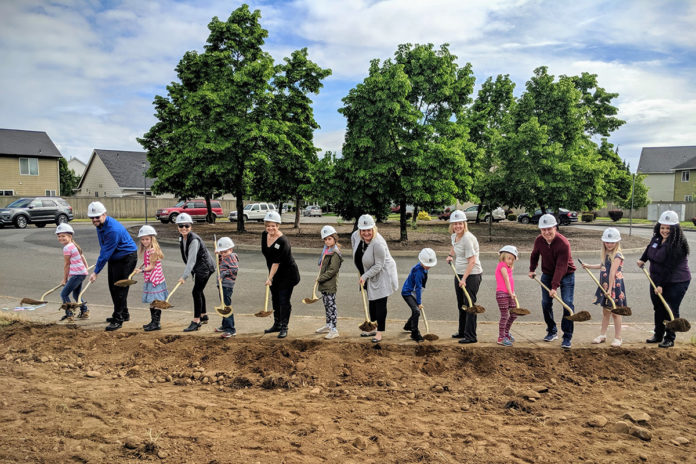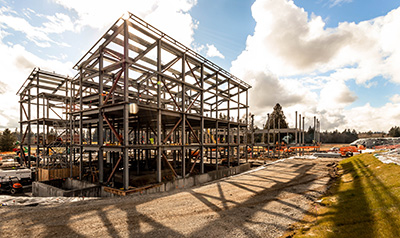
A construction boom has hit its stride in Vancouver schoolyards. Evergreen Public Schools and Vancouver Public Schools, together comprised of more than 50,000 students, have broken ground or begun the design phase of 26 new builds, rebuilds or additions. Dozens more schools will receive capital upgrades. The significant amount of construction over a relatively short period is pulling major players in all directions, and schedules are painstakingly created and adjusted to keep all the projects on time and on budget.
At Evergreen Public Schools, a $695 million bond measure was passed in February 2018. Combined with state matching funds and impact fees collected on behalf of the district, more than $800 million in construction projects will be completed by 2024. At Vancouver Public Schools, a $458 million bond measure passed just one year earlier. Fifteen major projects are underway or planned, and 25 more schools will have received capital improvements. VPS’s bond projects will be completed in 2021.
EPS hired Yamhill, Ore.-based R&C Management Group to manage the seemingly vast group of area general contractors and architects hired for the collection of projects: Skanska, Emerick Construction Co., Pence and Triplett Wellman Contractors alongside LSW Architects, GBD Architects and Mahlum Architects. A set of six guiding principles and nine design drivers developed early in the process keep the whole set of projects running smoothly, said Adam Cormack, partner and senior manager with R&C, which has managed public school projects throughout Southwest Washington, including in Washougal and in the Columbia Gorge.
The guiding principles and design drivers came together as part of the Bond planning process, at the end of 2017 and the beginning of 2018, said EPS Executive Director of Communications Gail Spolar, and the process was School Board staff- and community-stakeholder driven. Later, once the bond passed and the contractors were on board, Mahlum Architects held three symposium workshops “to come to some common understanding of what they meant.”
Managing marketplace conditions
Evergreen is the largest school district R&C has worked with, and the challenges of managing this many projects with during a local construction boom cannot be overstated. Cormack said he relies heavily on industry relationships to keep things running smoothly.
“I try to be fair, try to let them know what’s in the pipeline, what projects are coming up. With more difficult projects, we can use alternative methods,” he said. And because the process from Bond to build can be years, initial budget estimates tend to rise based on inflation, so “we have appropriate contingencies built in.”
On the other side of town, four different general contractors have broken ground on five major Vancouver Public Schools projects in the last year – nearly $188 million worth. Assistant Superintendent for facility planning Todd Horenstein said, “the marketplace conditions” make it extremely challenging. “There’s so much general construction work in the area – not just schools – that finding a skilled and qualified labor force is difficult for the general contractors.”
VPS has contracted with Vancouver-based LSW Architects and Bassetti Architects, with offices in Portland and Seattle, on its bond projects. To help mitigate those challenges, VPS “spent a lot of time with stakeholders in the early planning work,” said Horenstein.
In most cases, he said, the jobs were design-bid-build, as public projects usually are, in three cases, a GCCM, or General Contractor Construction Management, process was utilized – the new combined Marshall Elementary School / McLoughlin Middle School; an addition to Columbia River High School; and VITA, Vancouver Innovation, Technology and Arts Elementary School, to be located downtown. Marshall/Mac and Columbia River are being built on active school sites. VITA is a brand-new elementary school in a premier location adjacent to the Vancouver Community Library.

The magic of Rick Magistrale
Three projects in the Evergreen schedule are also GCCM. Pence Construction’s Rick Magistrale is the superintendent on site at Sifton Elementary, the oldest school in the EPS district. Pence was brought on early in the process because of the active school on site, and was pleased to work closely with LSW Architects on the “constructability” of the project, particularly on the building envelope, which is crucial to the life and health of any building.
Because there are so many architects and contractors working on EPS’s bond projects, they have to collaborate and cooperate to imbue a similar spirit from school to school. Recently, Magistrale visited Henrietta Lacks Health and Bioscience High School to study a polished concrete floor Skanska completed there, and took it on as his personal challenge of excellence, he said, pointing to the middle of the active construction site, seeing the future floor in his mind.
Magistrale is a 32-year-construction veteran, a self-proclaimed “project chaser,” whose grandfather was a civil engineer. He lives and owns property in the EPS district, and his daughter will soon be teaching in one of its schools. He quite literally takes each project personally. When he began the Sifton replacement, Magistrale had a long ponytail. He cut it off, and, so the story goes, he won’t cut his hair again until the project is complete.
“This project means the most to me because I have a sense of ownership here,” he said.
The Catholic Italian father of four is also thrilled to be working near kids on site, and has brought several of them under his wing, including a blind student, who he brings onto the site to hear, touch and smell things, and of course to climb in the occasional big truck.
“I can tell which ones have a real interest,” he said. He orchestrated a ceremonial groundbreaking with dozens of community members and 400 kids. “I’ll never forget it.”
Building for future-ready graduates
Threads through the Evergreen projects include updated security measures, such as fewer access doors and more secure reception areas, coupled with updates such as open spaces, more natural light and increased access to technology. Spolar said much of the early conversation and research went into crime prevention through environmental design.
Not surprisingly, similar themes pervaded VPS’s designs, with a harkening back to the enclosed courtyards of mid-century schools so the students can have access to outdoor space with the added security of actually being indoors. Horenstein noted the pervasiveness of spaces meant for “problem-based learning” as well as an emphasis on arts, dance and music. He said at the heart of their design process was building schools for “future-ready graduates” who will need “critical skill sets in a changing workplace.”
In the end, really, it’s all about the kids.



